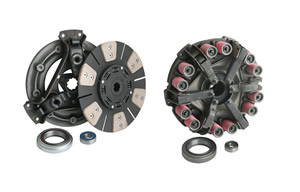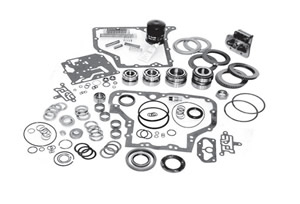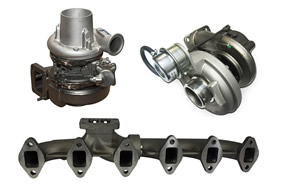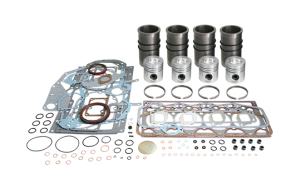Company Information and Early History
The company was formed in 1902 with the merger of two small tractor manufacturers, McCormick and Deering. Initially the fledgling company produced two ranges of tractors, the Mogul and the Titan. The Mogul was sold by McCormick dealers and the Titan by Deering dealers. The first IH tractor appeared in 1906 when the Type A petrol tractor was marketed with a choice of horsepower between 12, 15 and 20 HP.
The Type B soon followed and lasted until 1916. International also produced light trucks alongside its tractors. The Titan10-20 was built in Milwaukee, Wisconsin whilst the Mogul were built at the Chicago, Illinois factory. Other models 8-16, 15-30 and the Farmall Regular were produced in the 1920’s. The 8-16 tractor was the first tractor to offer a power take off as an optional extra which gave this tractor a competitive advantage and IH enjoyed great commercial success with this.
In the 1920’s the depression led to severe competition with Ford cutting tractor prices and IH reacting by offering a free plough with each tractor purchased. This again was a commercial success and this enabled new IH models 15-30 and 10-20 to be launched with a magneto ignition, improved clutch and built in PTO which gave them an edge over Fordson.
The International Harvester 10-20 remained in production until 1942 with 216,000 machines being sold in addition a larger 15-30 was offered, both tractors were powered by in–line 4 cylinder petrol paraffin with overhead valves and replaceable cylinder liners. A crawler version of the 10-20 was unveiled in 1928 known as the Trac Trac Tor and latterly the T-20. In 1924 International Harvester produced the Farmall, the first proper row crop tractor could be used for ploughing but also cultivation of cotton, corn and other crops. The tractor was refined and redesigned when the Farmall regular became one of a three models F-20, F12 and F-30. International Harvester dropped its hitherto traditional grey paint scheme during the 1930’s and replaced it with red, the effect of this change was two-fold.
The tractors were more visible to other motorists as they become more widely used on the roads and more noticeable to potential buyers including the USSR where the tractor was so popular 15-30 tractor was produced in factories in USSR.
Diesel Powered Tractors
The first IH wheeled, diesel powered tractor appeared in 1934, designated the WD-40, it was powered by a 4 cylinder engine and the HP rating was 44. The engine was slightly unusual in that it was started on petrol and once warm switched to diesel by the closure of a valve.
The Letter and Standard Series
The International W6 was announced in 1940 as part of a range of new tractors, the range also included the W4 and W9 models, all were powered by an in-line 4 cylinder engine producing 37HP when running on gasoline. The diesel version was designated the WD6. In the late 1930’s the IH trademark was changed together with the styling of the tractor, moving to a rounded radiator grille with horizontal slots. The new styling was initially introduced on crawler tractors but soon afterwards the Farmall M models adopted the same styling. This sleek look combined with other features became known as the Farmall “letter” series (A, B, BN, C, H and M) and the McCormick Deering “standard series” (W-4, W-6 AND W-9) . Model year 1941 saw the introduction of the model “MD”, the first row crop diesel powered tractor, it would be more than a decade before IH’s largest competitor John Deere would introduce that same option. The letter series tractors were updated to the “super” series in 1953. Many of these tractors especially the largest H, M and W are still in operation on farms today. Especially sought after by collectors are the diesel powered MD, WD-6 and WD-9. The letter and standard series of tractor were produced until 1954 and was the defining product in IH history.
In 1947, the smallest tractor in the Farmall range was introduced called the Cub, the Cub was aimed at small acreage farms but was also sold as a second tractor for larger farms. The Cub proved extremely popular with the original design continuing in production without significant change until 1979.
In 1955 the numbered "hundred series" was offered, although with slightly different looks it was still heavily based on the models introduced in 1939. The only new tractor in the 1955 line up was the 300 Utility. In 1957 IH gave a further update by increasing power in some models and adding an new 230 utility with new white paint on grill and sides, whilst sales improved IH inability to change and update its tractor range was beginning to show.
60 Series Problems
In July 1958, IH launched a major launch of a new line of tractors to revitalise slumping sales. The IH 60 series included the first of its kind 6 cylinder 460 and 560 tractors, the initial successful sales launch was curtailed by IH having to campaign recall the 460, 560 and 660 tractors due to final drive component failure. IH in their desire to become the first big-power manufacturer had failed to upgrade the final drives to cope with the extra power, as a consequence of this IH lost many customers in the ensuing months with customers moving to John Deere’s new generation of Power tractors introduced in 1960.
1960’s-1970’s
In 1964 IH made its 4 millionth tractor. In 1965 IH introduced its first 100HP tractor and first factory installed cab.
In 1971, IH introduced the 66 series, In 1974 IH made its 5 millionth tractor. In 1973 it dropped the “Farmall” name from its tractor. In 1976 the entire tractor line got a new paint job and decal pattern, the side panels changed from all white with chrome and black decals to all red with a black striped decal.
1980’s
In 1981 IH launched the 50 and 30 series tractors which were designed by Gregg Montgomery who later designed the CASE IH “Magnum” series of tractors. The technical innovations in this series of tractor included:
- Computer monitoring system
- 18 speed synchronised transmission
- New rear hitch system
Downfall
Throughout the 1960’s and 1970’s despite good sales , the profitability remained meagre, the continual addition of unrelated business lines resulted in the company having difficulty in focusing on its primary business that of agricultural equipment, construction equipment or truck production.
In 1979 a new CEO was appointed determined to improve profit margins, by the end of the year profit had improved but the production cutbacks and cost cutting measures caused the UAW to strike on November 2 1979, the strike lasted approximately six months which together with an economy downturn put the company in a financial crisis. Following long negotiations IH agreed to sell selected assets of its agricultural products division to Tenneco Inc on November 26 1984, Tenneco had a subsidiary J I Case , that manufactured tractors, but lacked the full line of farm implements that IH produced notably combines , cotton pickers, tillage equipment etc.
On May 14 1985 the last IH tractor rolled off the factory line as a consequence of the sale of the company to Tenneco Inc, with the production of the new Case IH tractors being moved to JI Case Tractors in Racine, Wisconsin.
The truck and engine division remained, and in 1986 Harvester changed its corporate name to Navistar International Corporation, Harvester had sold the International Harvester name and IH symbol to Tenneco.
Navistar International continues to manufacture medium and heavy duty trucks, school buses and engines under the International brand name.







 Just Template IT
Just Template IT